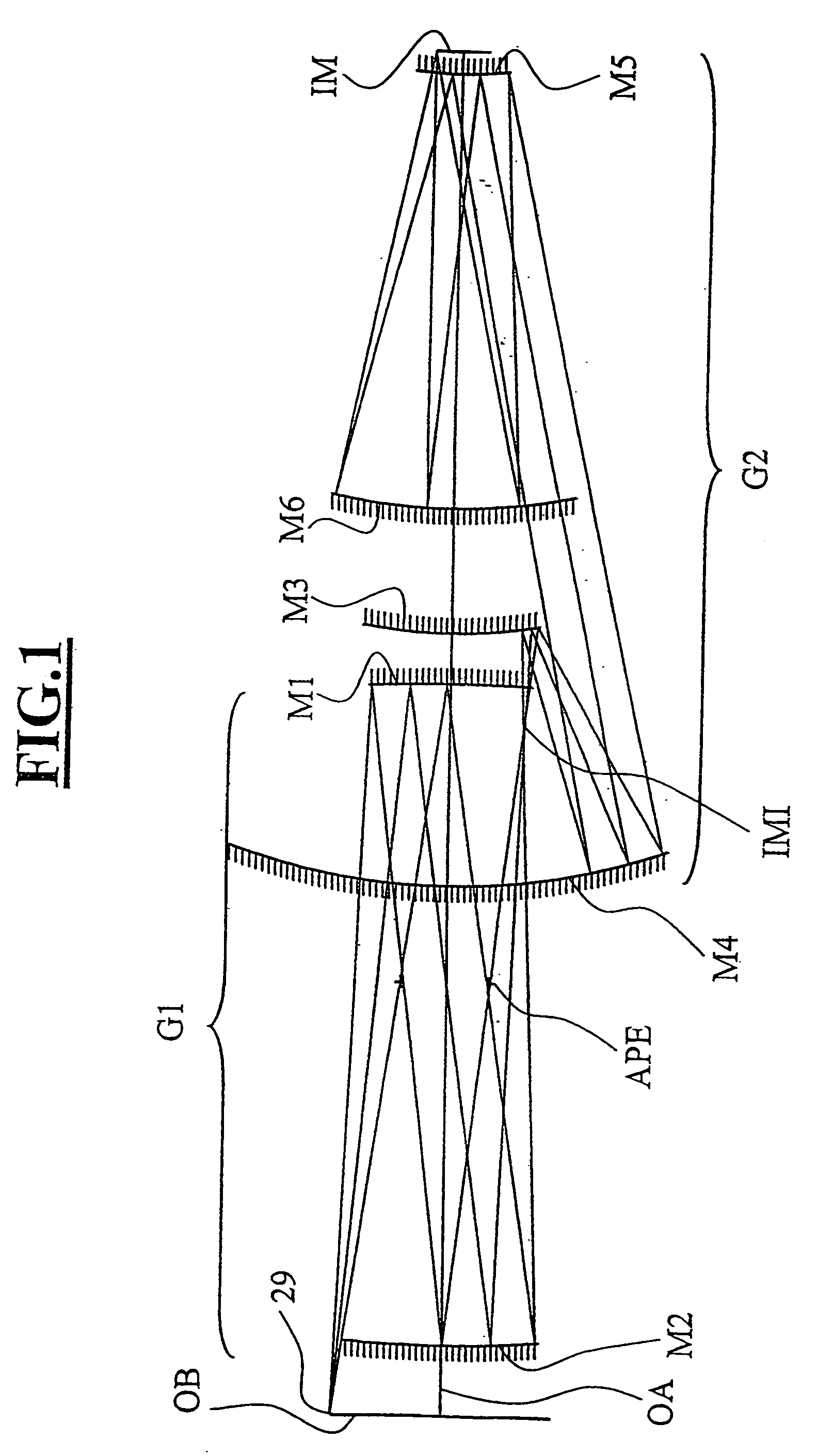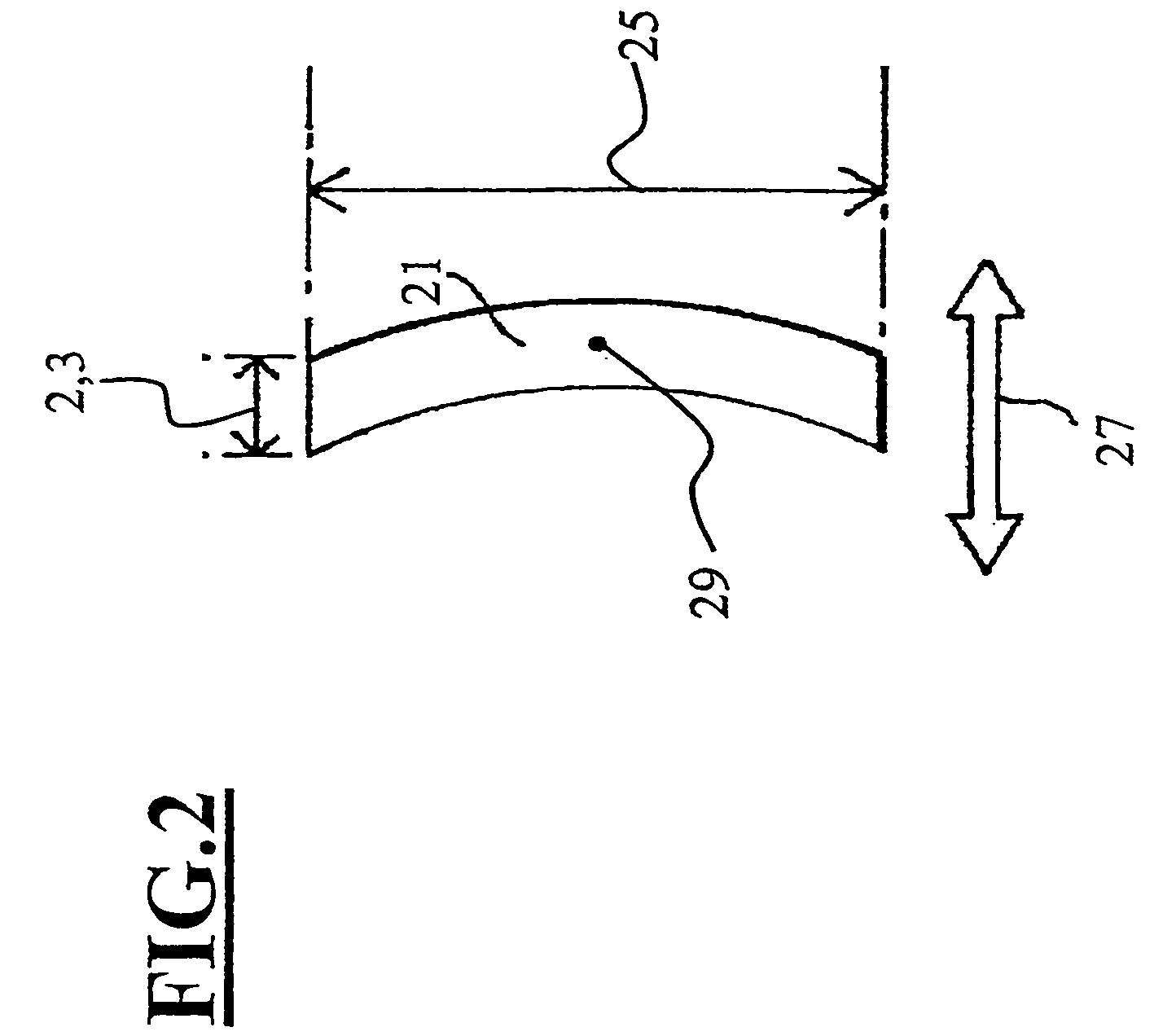Projection system for EUV lithography
a projection system and lithography technology, applied in the field of microlithography objectives, can solve the problems of reducing the throughput of the entire projection apparatus, the system is very long (3000 mm), and the examples are not well suited to contemporary lithography at extreme ultraviolet wavelengths, etc., to achieve the effect of efficient masking of undesired light, simple manufacturing and mechanically easy to achiev
- Summary
- Abstract
- Description
- Claims
- Application Information
AI Technical Summary
Benefits of technology
Problems solved by technology
Method used
Image
Examples
first preferred embodiment
[0061]FIG. 1 shows a plan view of a first preferred embodiment, and, taking in conjunction with Table 1 and Table 2, provides an illustrative, exemplary description of this embodiment. Light impinges on an object, e.g. a reflective mask or reticle from an illumination system and is directed to concave mirror M1 after which it reflects from the mirror M1 and passes through a physically accessible aperture stop APE that is located between Mirror M1 and M2. This aperture stop APE is located a substantial distance from the first concave mirror M1 and, likewise, this aperture stop APE is located a substantial distance from concave mirror M2. After the illumination reflects off concave mirror M2, the light comes to a focus at an intermediate image IMI that is located in close proximity to convex mirror M3. From mirror M3 the illumination is directed toward concave mirror M4 where the light is nearly collimated and directed toward convex mirror M5. Upon reflection from mirror M5, the light...
second preferred embodiment
[0070] In a second of these general embodiments, an optical projection system for extreme ultraviolet (EUV) lithography including six mirrors arranged in a PPNPNP configuration is disclosed. The plan view of this second preferred embodiment is shown in FIG. 3, which demonstrates a PPNPNP configuration designed for EUV lithography at a wavelength of 13.4 nm. Like the first preferred embodiment, the system is reimaging, and unlike the '310 and '079 embodiments, locates the intermediate image IMI′ before the second mirror pair. In this example, the intermediate image IMI′ is located between mirror M2′ and M3′, helping to promote low incidence angle variation across mirror M5′. This construction also enables low mean incidence angles on mirror M1′, M2′, M4′, and M6′. These low incidence angles are advantageous for maintaining good multilayer compatibility. The aperture stop APE′ is located between M1′ and M2′ and is significantly spaced from either mirror, e.g., more than 200 mm.
[0071]...
third preferred embodiment
[0077] The third preferred embodiment is shown in FIG. 4. Like the first and second preferred embodiments, this system utilizes a re-imaging PPNPNP configuration with a physically accessible aperture stop APE″ that is located between the primary mirror M1″ and secondary mirror M2″. And like the first and second embodiments, the intermediate image IMI″ is located between the secondary mirror M2″ and the tertiary mirror M3″. Similar to the second embodiment, the tertiary mirror M3″ is located on the object side of the primary mirror M1″. This particular embodiment differs from the second preferred embodiment in that the chief ray CR″ from the central field point 29″ converges toward the optical axis OA″ after reflection from the secondary mirror M2″, thus forming another advantageous projection system with distinct characteristics.
[0078] The optical prescription for this third embodiment of FIG. 4 is listed in Table 7 and Table 7. Table 7 lists the vertex radius of curvature as well ...
PUM
| Property | Measurement | Unit |
|---|---|---|
| physical distance | aaaaa | aaaaa |
| physical distance | aaaaa | aaaaa |
| incidence angle | aaaaa | aaaaa |
Abstract
Description
Claims
Application Information
 Login to View More
Login to View More - R&D
- Intellectual Property
- Life Sciences
- Materials
- Tech Scout
- Unparalleled Data Quality
- Higher Quality Content
- 60% Fewer Hallucinations
Browse by: Latest US Patents, China's latest patents, Technical Efficacy Thesaurus, Application Domain, Technology Topic, Popular Technical Reports.
© 2025 PatSnap. All rights reserved.Legal|Privacy policy|Modern Slavery Act Transparency Statement|Sitemap|About US| Contact US: help@patsnap.com



